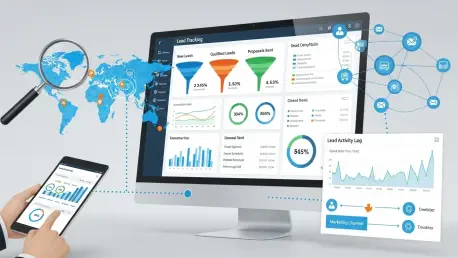This guide aims to equip companies with the knowledge and tools to efficiently track and manage leads, turning potential customers into loyal clients. Imagine a business losing half of its prospective customers simply because it failed to follow up on inquiries or understand their needs. This scenario is all too common, with studies showing that nearly 80% of leads never convert due to poor management. The stakes are high in today’s competitive market, where every missed opportunity can cost significant revenue. This comprehensive resource will explore practical steps and strategies to ensure no lead slips through the cracks, ultimately boosting conversion rates and fostering sustainable growth.
The purpose of this guide is to provide a clear roadmap for businesses looking to refine their sales and marketing efforts through effective lead tracking. By implementing structured processes and leveraging modern technology, companies can gain deeper insights into customer behavior and prioritize their resources toward high-value prospects. The importance of this cannot be overstated—without a robust system, businesses risk wasting time, money, and effort on unqualified leads while neglecting those most likely to convert.
Understanding the impact of lead management goes beyond just numbers; it shapes how a company builds relationships and establishes trust with its audience. A well-executed strategy not only drives profitability but also creates a foundation for long-term success in an increasingly crowded marketplace. The following sections will break down actionable steps and highlight innovative tools to help businesses stay ahead of the curve.
Why Lead Tracking Is Essential for Business Success
Lead tracking stands as a fundamental pillar for any company aiming to thrive in a dynamic business environment. It ensures that resources are allocated efficiently, preventing the squandering of budgets on uninterested prospects. By systematically monitoring interactions with potential customers, businesses can identify which strategies resonate most and adjust their approaches accordingly, saving both time and financial investment.
Neglecting lead management can have dire consequences, such as missed sales opportunities and diminished brand reputation. Companies that fail to follow up promptly or nurture relationships often find themselves losing ground to competitors who prioritize these efforts. The ripple effect can stunt growth, as a weak customer base struggles to support expansion or sustain operations during challenging periods.
Fortunately, effective lead tracking offers a solution by enabling businesses to build a robust pipeline of engaged prospects. This guide will delve into the critical steps for establishing such a system, from defining leads to leveraging cutting-edge software. The benefits include not only increased conversions but also the ability to foster loyalty and drive consistent profitability through informed decision-making.
The Evolution and Importance of Lead Management Technology
Lead management technology has transformed significantly over recent years, evolving from basic spreadsheets to sophisticated platforms that integrate seamlessly with other business systems. Initially designed to record simple contact details, these tools now capture a wide array of data points, providing a detailed picture of customer interactions. This progression has made it possible for companies to monitor every touchpoint, from email opens to website visits, with precision.
The primary purpose of this technology lies in its ability to offer actionable insights into sales and marketing performance. By analyzing data collected through various channels, businesses can pinpoint which campaigns drive engagement and which fall flat. Such clarity empowers decision-makers to refine strategies, allocate budgets effectively, and ultimately enhance outcomes across departments.
In today’s competitive landscape, integrating lead management with other tools like customer relationship management (CRM) systems is no longer optional but essential. This synergy allows for a unified view of customer journeys, ensuring no detail is overlooked. As markets grow more saturated, adopting these technologies becomes a key differentiator, enabling companies to stay responsive and relevant amid constant change.
Step-by-Step Guide to Tracking and Managing Leads Effectively
Step 1: Define and Prioritize Potential Customers
The foundation of successful lead tracking begins with clearly defining who qualifies as a lead for a business. This involves setting specific criteria, such as whether a prospect has shown interest through a form submission or repeated website visits. Establishing these parameters helps in distinguishing genuine opportunities from mere passersby, ensuring focus remains on those with real potential.
Once leads are identified, prioritization becomes the next critical task. Not all prospects carry the same value; some may be ready to purchase, while others need nurturing. Segmenting leads based on their likelihood to convert allows companies to allocate resources wisely, targeting high-priority individuals with tailored messaging and timely follow-ups.
Key Criteria for Lead Classification
To classify leads effectively, businesses should consider factors like engagement level, such as email responses or content downloads, alongside demographic data that aligns with the target audience. Purchase intent, often gauged through actions like requesting a demo, also plays a vital role. These elements create a framework for distinguishing between casual interest and serious consideration.
Benefits of Prioritization
Prioritizing leads offers substantial advantages by streamlining efforts toward the most promising prospects. This approach saves time, allowing sales teams to focus on closing deals rather than chasing unlikely conversions. Additionally, it optimizes resource use, ensuring marketing budgets are spent on campaigns that yield the highest return on investment.
Step 2: Implement Lead Capture Systems
Capturing lead information efficiently requires the deployment of user-friendly systems designed to collect data at multiple touchpoints. Tools such as landing pages with clear call-to-action buttons, contact forms on websites, and web analytics platforms can gather essential details without overwhelming potential customers. The goal is to make the process seamless for users while ensuring data flows into a centralized database.
Beyond just collection, the design of these systems must prioritize accessibility and functionality. For instance, forms should be concise, asking only for necessary information to avoid deterring submissions. Integrating these tools with existing platforms ensures that data is readily available for analysis and follow-up actions by relevant teams.
Choosing the Right Capture Tools
Selecting appropriate tools involves assessing business needs and compatibility with current systems. Options range from standalone form builders to comprehensive marketing suites that offer built-in analytics. The chosen solution should support scalability and provide integration capabilities to sync with CRM software for a cohesive workflow.
Ensuring Data Accuracy
Accurate data forms the backbone of effective lead management, making validation processes crucial. Implementing checks to filter out incomplete or duplicate entries helps maintain a clean database. Regular audits and standardized formats further ensure that the information remains reliable for strategic decision-making.
Step 3: Utilize Lead Scoring Techniques
Lead scoring assigns numerical values to prospects based on their behaviors and engagement levels, helping to identify those most likely to convert. This method allows businesses to rank leads, ensuring sales teams prioritize efforts on individuals showing strong interest, such as frequent interactions with marketing content or direct inquiries.
A well-structured scoring system provides clarity on where each lead stands in the buying journey. For example, a prospect who attends a webinar might receive a higher score than one who only views a blog post. This differentiation guides follow-up strategies, making outreach more targeted and effective.
Designing an Effective Scoring Model
Creating a scoring model tailored to specific goals involves defining key actions that indicate interest, such as downloading a whitepaper or requesting a quote. Assigning weighted values to these actions reflects their importance in the conversion process. Collaboration between sales and marketing teams ensures the model aligns with overall objectives.
Adjusting Scores Over Time
Lead behavior evolves, necessitating periodic updates to scoring models. A prospect initially showing high engagement might cool off, while another could suddenly express renewed interest. Regularly reviewing and adjusting scores based on current data keeps the system relevant, ensuring resources are directed toward active opportunities.
Step 4: Monitor Lead Behavior and Interactions
Tracking how leads interact with a company’s digital presence and sales efforts offers invaluable insights into their interests and readiness to buy. Monitoring activities like page visits, time spent on specific content, or responses to email campaigns reveals patterns that can inform personalized engagement strategies.
This ongoing observation helps in identifying critical moments in the customer journey, such as when a lead repeatedly explores pricing pages, signaling potential purchase intent. Armed with this knowledge, businesses can time their outreach for maximum impact, addressing needs at the right moment to boost conversion chances.
Tools for Behavioral Tracking
Various tools facilitate behavioral tracking, from analytics platforms that monitor website activity to email marketing software tracking open and click rates. Selecting solutions that provide detailed reports and real-time updates enables companies to stay proactive. Integration with other systems ensures a comprehensive view of all interactions.
Interpreting Behavioral Patterns
Analyzing behavioral data requires looking beyond surface-level metrics to understand underlying trends. For instance, a spike in engagement after a campaign launch might indicate effective messaging, while a drop could suggest content fatigue. Translating these patterns into actionable steps, such as refining email content, enhances overall strategy effectiveness.
Step 5: Analyze Data for Continuous Improvement
Regularly reviewing lead data is essential for measuring the success of tracking initiatives and identifying areas for enhancement. This analysis involves examining conversion rates, engagement metrics, and other indicators to assess whether current approaches meet set goals. A consistent evaluation schedule ensures issues are caught early.
Data analysis also uncovers opportunities to optimize processes, such as spotting underperforming campaigns or segments with untapped potential. Adjusting tactics based on these findings keeps strategies aligned with evolving market conditions and customer preferences, maintaining a competitive edge.
Metrics to Focus On
Key performance indicators like conversion rates, cost per lead, and average time to conversion provide a clear picture of tracking effectiveness. Engagement metrics, such as click-through rates on emails, also offer insights into audience interest. Focusing on these figures helps in benchmarking progress and setting realistic targets.
Turning Insights into Action
Transforming data insights into practical changes involves identifying specific pain points, like low response rates to certain campaigns, and testing alternative approaches. Collaboration across teams ensures that adjustments in marketing copy or sales pitches are data-driven. This iterative process fosters continuous growth in lead management outcomes.
Step 6: Leverage Lead Management Software
Adopting lead management software streamlines the tracking process by automating repetitive tasks and organizing data into accessible formats. These platforms centralize information, making it easier to segment leads, schedule follow-ups, and generate reports. Automation reduces manual errors, freeing up time for strategic focus.
The integration of such software with CRM and marketing automation tools creates a unified system where data flows seamlessly between functions. This connectivity ensures that sales teams have up-to-date information on lead status, enabling more informed interactions and quicker response times to inquiries.
Features to Look for in Software
When selecting software, key features to prioritize include automation for tasks like email scheduling, detailed reporting for performance tracking, and integration with existing tools. User-friendly interfaces and customizable dashboards also enhance usability. Scalability ensures the solution grows with the business over time.
Overcoming Common Software Challenges
Challenges like high costs or steep learning curves can hinder software adoption, but solutions exist. Starting with basic plans and scaling up as needs grow manages budget constraints. Comprehensive training and support resources help teams adapt quickly, minimizing disruptions during implementation.
Combining Lead Management with Call Tracking for Greater Impact
Integrating lead management with call tracking offers companies a more complete understanding of customer interactions across channels. While lead management focuses on nurturing prospects through digital touchpoints, call tracking captures data from inbound phone calls, revealing which campaigns drive direct contact. This dual approach enriches the overall dataset available for analysis.
The combined insights allow for a deeper evaluation of marketing effectiveness, as businesses can correlate call volume with specific ads or promotions. This holistic view supports better budget allocation, ensuring funds are directed toward high-performing initiatives. It also aids in identifying gaps in customer engagement that might otherwise go unnoticed.
Synergies of Lead and Call Data
Merging data from lead management and call tracking enhances decision-making by providing a fuller picture of prospect behavior. For example, a lead showing online engagement who also calls for information might be fast-tracked for follow-up. This synergy helps in crafting strategies that address both digital and direct communication preferences.
Personalizing Customer Outreach
Using integrated data, companies can tailor outreach efforts to individual needs, such as referencing a recent call in a follow-up email. Personalized messaging based on combined insights increases relevance, improving the likelihood of positive responses. This targeted approach also enhances customer experience, fostering trust and loyalty.
Key Takeaways for Effective Lead Tracking
- Define and prioritize leads based on clear criteria to focus on high-value prospects.
- Set up efficient capture systems to collect accurate and actionable data.
- Use scoring techniques to identify and focus on leads with the highest conversion potential.
- Track behavior to uncover patterns and trends that inform engagement strategies.
- Analyze data regularly to optimize sales and marketing efforts for better results.
- Adopt lead management software to automate processes and improve efficiency.
- Integrate call tracking to gain a comprehensive understanding of customer interactions.
Future Trends and Challenges in Lead Management
Lead management continues to evolve with advancements in technology, particularly through artificial intelligence and machine learning, which enable predictive analytics for more accurate lead scoring. These innovations allow businesses to anticipate customer needs with greater precision, tailoring interactions to boost conversions. Staying abreast of such developments is crucial for maintaining a competitive advantage.
Data privacy regulations are also shaping the landscape, requiring companies to balance effective tracking with compliance to legal standards. Adapting to these rules while ensuring transparency with customers presents a challenge but also an opportunity to build trust. Implementing secure systems that protect user information is now a priority.
Looking ahead, the integration of emerging tools offers immense potential for personalization in lead strategies. However, businesses must navigate hurdles like technology adoption costs and skill gaps within teams. Proactive investment in training and scalable solutions can position companies to leverage these trends for enhanced efficiency and customer satisfaction.
Final Thoughts: Building a Stronger Customer Base Through Lead Tracking
Reflecting on the journey of establishing robust lead tracking systems, it becomes evident that consistent application of structured steps yields significant improvements in customer engagement. Companies that committed to defining leads, implementing capture tools, and analyzing data saw measurable growth in their conversion rates. This dedication laid a solid foundation for nurturing relationships that translated into a loyal client base.
Taking the next step involves exploring advanced tools and integrations, such as combining lead management with call tracking, to deepen insights into customer behavior. Businesses that ventured into these areas discovered new ways to personalize outreach, setting themselves apart in crowded markets. This adaptability proved essential in responding to evolving demands.
For those looking to build on these achievements, a thorough assessment of current lead management practices offers a clear starting point. Identifying gaps and investing in suitable software or training paves the way for sustained progress. Embracing continuous improvement ensures that past efforts culminate in a stronger, more responsive approach to customer acquisition and retention.









